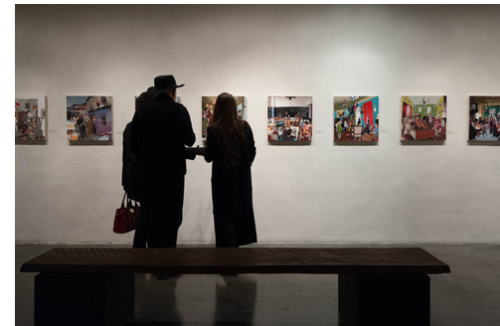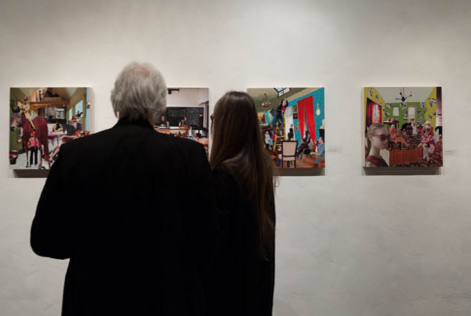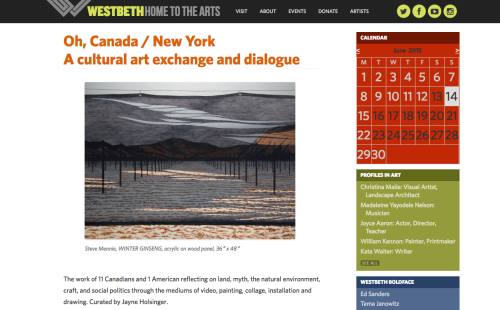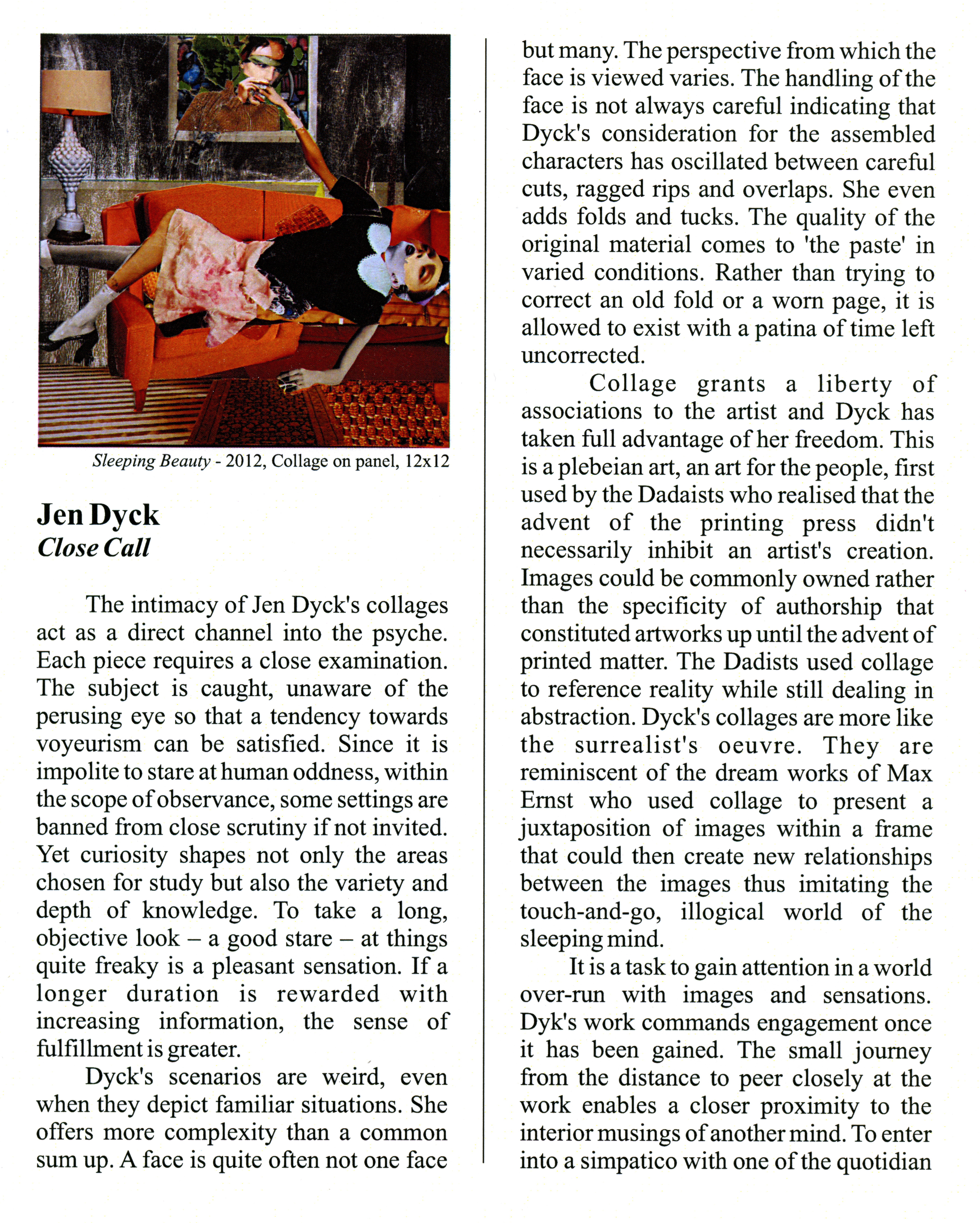CROSSING THE LINE ART EXHIBITION
June 2017
Margaret Martin Gehman Art Gallery
Eastern Mennonite University
Harrisonburg, Virginia

Dr. Rachel Epp Buller, curator
Artists are in the habit of crossing lines. In 1917, Marcel Duchamp caused an uproar by submitting to an exhibition a mass-produced urinal that he had signed, titled, and declared art. In 1989, Andres Serrano drew fire when several prominent Republicans in the United States Congress objected to his receipt of National Endowment for the Arts funding for his religiously themed photographs that achieved saturated colors through the use of materials such as blood and urine.1 The collective known as the Guerrilla Girls regularly raises a ruckus with their activist informational posters that draw attention to the disparities of gender and race representation in the art world, calling out museums and gallerists by name for their discriminatory practices. And just this year, the online art daily Hyperallergic has been awash in articles of activist artists protesting gentrification, the occupation of Palestine, the underwhelming global response to the Syrian refugee crisis, as well as many of the policies and executive orders of the Trump administration still in its infancy.
Editor’s Note: While Anabaptist Historians generally focuses on historical research, in the interdisciplinary spirit of “Crossing the Line”, we are broadening our scope during this series to include a wide variety of Anabaptist studies.
Artists affiliated with Anabaptist traditions cross lines in ways quiet and bold, subtle and overt. The conference during which this exhibition takes place, Crossing the Line: Women of Anabaptist Traditions Encounter Borders and Boundaries, invited presenters to consider border- and boundary-crossings in terms of ethnic and religious heritage, gender and sexual identity, geographic borders, private and public spaces, or disciplinary expression. The artists included in this exhibition most often cross lines in order to experiment and question, to make statements, or to think back through time.
A number of the artists represented here cross temporal borders and the boundaries of memory as they engage with the stories of ancestors. In her panels from Nine Tetrameters, Jayne Holsinger collapses varied historical references. Working in a four-patch quilt block format, Holsinger crosses easily between visual echoes of fabric patterns, historical prints, and bread baking, all modes of reaching out to the women of her Anabaptist heritage. Three prints by Gesine Janzen speak to her paternal family’s history of emigration from Poland’s Vistula Delta to central Kansas. By exploring the narratives evoked by historic photographs and letters, Janzen imagines a cross-generational dialogue, moving their stories forward across the decades and offering a meditation on family, intimacy, and absence. Teresa Braun’s video, The Plaint, explores family lore surrounding a specific place. A family cemetery and the fusion of human and plant organisms feature as mythological elements in Braun’s weaving of a fragmented ancestral narrative. Teresa Pankratz’s multi-act The View from a House in Kansas, excerpts of which are included in this exhibition and other parts of which will be performed during the conference, engages with semi-fictional narratives revolving around the artist’s childhood home, which was destroyed by fire some years ago.
Other artists purposefully cross borders of material. Historically, the highly regarded “fine arts” materials of painting and sculpture have far outweighed the importance of craft traditions such as needlework. However, one important legacy of the Feminist Art Movement of the 1970s has been the revaluation of media long denigrated as “women’s work.” Karen Reimer employs methods of embroidery and appliqué not only to bring feminized craft traditions into a high art context but also as a means by which to question the value of certain kinds of labor and notions of originality. Reimer intentionally copies her texts from other contexts as a way to destabilize definitions of creativity and innovation. As she writes, “Generally speaking, in the art world copies are of less value than originals. However, when I copy by embroidering, the value of the copy is increased because of the added elements of labor, handicraft, and singularity–traditional sources of value. The copy is now an ‘original’ as well as a copy.”2 At the same time, Reimer’s hand-sewn texts sometimes border on illegibility, producing a bad copy and inviting us to question the relative value of such painstaking labor. Kandis Friesen seeks to examine how textiles and other materials might impart narratives about migration and exile. In Onsa Japse Jeit Jantsied,a drawing sewn onto leather makes reference to both indigenous and colonial histories. Friesen draws on a clothing pattern from a Russian Mennonite museum artifact from the 1800s, one that also incorporated buffalo skin from newly colonized lands. Like Gesine Janzen, Friesen looks to visual culture as a connection between the past and the future, yet in this case she also problematizes the narrative of hard-working Russian Mennonite immigrants as she uses textiles to implicate the diaspora’s participation in colonial processes.

Mary Lou Weaver Houser and Jen Dyck cross boundaries of medium through their work with found materials. Dyck’s collages investigate dream imagery, in some cases, and in others, such as Potluck, speak to her personal experiences of Anabaptist cultural traditions. Weaver Houser, on the other hands, positions her mixed media assemblages as metaphors: as she walks an edge between varied art materials, she also imagines edges – between generations, between different world views, between what is and what could be.3 Similarly, Jessie Pohl crosses material boundaries and points to the possibility of crossing emotional bridges as well. As she incorporates the unexpected material of scrap lumber as the substrate for delicate pen-and-ink drawings, she emphasizes a contrast of strength and vulnerability.
Some artists cross lines as a political gesture, seeing their methods as a way to issue public statements, either subtle or explicit. In Blamed Shamed Abandoned, one from a series of 60 paintings, Jerry Holsopple directly addresses the failures of U.S. Mennonite communities to protect, believe, or even listen to the many women abused by well-known Mennonite theologian John Howard Yoder. Holsopple grapples in his expressive portraits with the idea of collective responsibility and he explicitly brings the issue of sexual abuse out from behind closed doors, for public discussion and accountability. Audra Miller’s The Gender Project, which is represented here by two photographic diptychs, explores what it can mean to cross between feminine and masculine gender presentations. Through Miller’s photographs, we see not only the possibilities of either/or but also of in-between, of gender identities that are not always so easily classified in a binary system.
Lora Jost regularly engages with political activism, on topics ranging from local school closures to the local and global impacts of climate change. In her piece for this exhibition, Jost emphasizes more broadly the importance of critical thinking in our world. Informed by her experiences of a Mennonite historical focus on peace and social justice, Jost uses a combination of text and linework to ask the viewer to more carefully consider, when confronted with any issue of substance, “Does this make sense?” Jennifer Miller takes on a topic with both personal and political meanings in addressing the Keystone XL pipeline. Crude, a mixed media drawing, makes topographical references to the proposed path of crude oil transfer from the Tar Sands of Alberta to the Gulf Coast. The map follows the same path traveled by Miller’s family in their move from north to south for her father’s job as a pilot for the oil industry, pointing to complicated convergences of politics, business, childhood memories, and a family’s financial security. While the pipeline was halted under President Obama in 2015, a new administration has proven more receptive to the interests of big oil and Miller’s piece becomes relevant for political discussion once again.
Our Anabaptist ancestors wrestled with the idea of how to be in the world but not of it, an intentional choice not to cross borders. The art on display in this exhibition might be seen to run the gamut between insularity and worldliness, yet each artist thoughtful engages with notions of borders and boundaries. Whether speaking to themselves and their Anabaptist communities or to much broader audiences, these artists traverse edges of materials, politics, identity, generation, and memory, and they invite us to join them on the journey.
UNCHARTED
Sopa Fine Arts Gallery
March 2017





SOPA Fine Arts ‘Uncharted’ March 2017
Jen Dyck. Evoking the marvelous and illogical life of dreams.
Jen Dyck’s work in collage is ambiguous and mysterious. Primarily self-taught as an artist, she has a background in music and literature, with a Diploma in Piano from the Royal Conservatory of Music in Toronto and a degree in Classics from the University of Winnipeg. She now lives in Salmon Arm. Her early work centred on painting and drawing, onto which from about 2005 she increasingly attached paper collage to the compositions. Since 2013, her work has been entirely focussed on collage.
Dyck’s collages are photomontages in which she compiles elaborate compositions by cutting out and making images from a wide array of photographs in magazines, uniting disparate parts, breaking up and reassembling forms. Collage is an art concept associated with the beginnings of modernism and was first used by Picasso and Braque from 1912 in their abstract Cubist works. Collage was used extensively by the Surrealists who constructed images juxtaposing unlikely elements for deep psychological effect, and Dada artists whose films disrupt the viewers expectations of conventional narrative. More recently it was employed by Pop artists including British artist Richard Hamilton. Though not derived from Hamilton, Dyck’s work shows an affinity with his collaged compositions.
With an interest in social commentary and satire, she weaves fantastical stories in dreamlike narratives. Her own dreams generally inspire the central idea or theme, though sometimes just fragments of dreams are the starting point. She has a notebook by her bedside to capture the essence of her dreams. Manipulating the ideas, she extrapolates them into complex carefully “staged” theatre-like compositions. The work is extremely detailed with many minute elements and diminutive figures only just discernible. She carefully matches photos from many different sources, transforming the originals into provocative new designs. She creates a choreography of idiosyncratic images. In this slow exacting work there is a fastidious transcription from the original photos to the final composition pasted down onto board. Though she is working with thoroughly realistic photographic sources, due to the way she compiles them, her work has a feeling of reality very different from ordinary experience.
Dyck begins by building the background, like a theatre diorama, an architectural spatial illusion, onto which the action will unfold. This may be a series of rooms, as in Maddin’s Diner, outdoor buildings as in Fifth Business, or it may be an actual theatre as in No Tidy Ending in Sight. The theatre architecture for No Tidy Ending in Sight was assembled from two main photos from Google which Dyck had printed. Non-magazine images are an occasional source. The architecture in her work generally has a fairly naturalistic, conventional perspective which literally sets the stage, creating a spatial reality from foreground to background. Onto the background, she applies a myriad of details such as furniture and architectural details, food, human figures and animals, from large to minute, in surreal and irrational juxtapositions, like unrelated fragments of life. Objects collide and interpenetrate creating unexpected situations and new relationships, improvised like the jazz she plays. She consistently disrupts the perspective with shifts in scale from large to small with inexplicable discrepancies of scale. There are many sub themes which create unpredictable and mysterious relationships in the same work. The placement of different fragments is not completely lined up creating disjuncture.
Magazines, from which she gleans a rich and wide variety of elements, provide her primary material. Thus her work is photographically based appearing realistic, but due to the bizarre placement reality is consistently disrupted. Occasionally she may photocopy components so that she can get repeated images or photocopy her own drawing or writing for specific effects. Though most of Could Somebody Please Open One of Those Damn Bottles and Give It to Me is derived from magazine photos, the text on the blackboard is written by Dyck and then photocopied and applied. What she finds in magazines stimulates other ideas.
Dyck draws from art history in some images, for example, British artist Francis Bacon in Could Somebody Please Open One of Those Damn Bottles and Give It to Me; and Pablo Picasso and Andy Warhol in The Art of Bullfighting. Her chequered black and white flooring, often consisting of many different parts pieced together to give a sense of depth and space is drawn from the patterned floors of Flemish painting. But whether she employs it directly or not, an important affiliation is with the ideas of Surrealism itself, the disjuncture and layering of unrelated objects to undermine logical meaning. This is evident in both her collages and the accompanying texts which follow a sort of “stream of consciousness” of what immediately comes to mind and in which ideas flow unrestricted by rational thought. Though some of the work seems random, her detailed compositions are crafted with meticulous care.
The work Maddin’s Diner, 2016 is inspired by the Canadian filmmaker Guy Maddin’s film The Dead Father, 1985 whose film owes much to the dream-like tone of the Surrealists. In Dyck’s work, people in the foreground sit in a 1950s era diner but there is no connection between them, they are separate and isolated. Scale is slightly shifted, perspective tipped in places and figures are twisted compilations from different source photos. Scenes from Maddin’s black and white film play on four monitors. A Christ-like contemplative figure sits to the left; there is bread on the table and wine suggesting the holy sacrament. Dyck’s melodrama plays out with a series of disconnected tableaus.
The title of Could Somebody Please Open One of Those Damn Bottles and Give It to Me, 2016 suggests annoyance and frustration. To whom is this irritation addressed? No-one is moved by this question, in fact everyone in the scene ignores it, even the delinquent students writing lines on the black board. And the scene is very calm rather than disturbed. Students are at their easels each one painting a different naturalistic image. But there are drawings of screaming heads superimposed, based on one from British artist Francis Bacon’s Portrait of Pope Innocent X. Meaning in this work is elusive.
In Stand By Your Horse, 2016, Dyck has created a deep interior space, with various people sitting in a living room of a well-appointed home oblivious to the fact that there are three horses in the interior. The space itself has a fairly logical perspective. The patterned floor contributes to the deep spatial effect. But what are horses doing in the living room? None of this makes sense in the real world. In the background is a cowboy leading his horse, in the middle ground a jockey and rider and in the foreground a thoroughbred mounted by woman in traditional riding costume; while outside the window is another cowboy and in the mezzanine two artists are drawing a horse. The foreground horse is entirely twisted with the body facing backwards and the head cut from a different magazine photo facing forwards. The rider has a “feather” in her hat made up of two diminutive figures. A young boy with a helmet covering his head, stands next to the horse holding the horses leg, alluding tongue in cheek to the title.
The title No Tidy Ending in Sight, 2016 refers to the pie throwing occurring in various parts of the image. Yet even with the two large foreground figures involved in the throwing, this is just the starting point. There is greater emphasis on the architecture itself, the grand proscenium stage, the different operas taking place in the theatre balconies, and on pools of water in the auditorium and stage, as well as the swimmers. The flooding water is from one of Dyck’s dreams where it evoked fear. Are those figures in the water swimming or drowning? In dreams one can soon become the other. Dyck’s caption for this work is more explicit than most others, indicating that a particular dream is the source and she describes how the dream unfolds and relates to the final image. She expresses fear and sadness about the death of her father. Yet, she manipulates the ideas by adding many curious details, expanding on the dream.
Dyck has written long allusive captions for many of her collages. The work provides the reason to make the texts: the text flows from the work, not the other way round. Written in a stream of consciousness manner, their powerful expression reflect her literary background. But the texts are not explanatory, they do not elucidate the meaning of the collages. Mostly the texts are tangential, adding dimension and information or seemingly irrelevant ideas, which further obfuscate the images. The often playful titles provoke ideas which are not explicitly borne out by the work. In the same way that she has subverted the images, collaging unrelated elements to them, the texts accrue unrelated ideas piled one on top of another.
Jen Dyck’s intricate and enigmatic collages fascinate and challenge and demand close observation. There is so much going on everywhere you look. Bordering on the obsessive, the collages reflect her fertile imagination, an ongoing montage in the brain. Not rational, and charged with elusive meaning, she upsets conventional representation, evoking the marvelous and illogical life of dreams.
Patricia Ainslie,
Kelowna.
February, 2017
Westbeth Artist Brings Canada to New York
by Kurt Nemes,
Washington DC, 202-403 9084
knemes0@yahoo.com
Longtime West Village resident, artist Jayne Holsinger kicked off and curated an exhibition, “Oh, Canada/New York: An art and cultural exchange,” which features the work of 11 Canadian artists alongside her own. The show runs until July 19 at Westbeth’s Gallery, 55 Bethune Street. While quite a few of the artists are well known in Canada and have exhibited internationally, for others, this is their first exhibition in New York. Most live in or around the city of Kamloops, in the interior of British Columbia.
“Their motives are very strong, and they actively comment on ecological themes,” says Holsinger. Steve Mennie’s paintings focus on the alteration of the landscape by agro-business farming. Aganetha Dyck creates pieces from items used in honeybee hives that raise questions about inter-species communication and our interdependency with the small. Anne Kipling’s drawings are intimate fractals that languidly progress across the paper. Jen Dyck creates witty and dream-like narrative collages. Tricia Sellmer’s paintings, set in flower gardens, vibrate with saturated colors, and probe the extraordinary in the ordinary. Other artists on display are Teresa Braun, William Frymire, Laura Hargrave, Royden Josephson, Julie Oakes, and Marie Scott.
Holsinger had two goals in assembling this show. First, she aims to combat the notion that Canadian art developed in the shadow of America’s. Contemporary Canadian art, instead, grew in parallel to that in the States and shared many of the same European influences. For example, Emily Carr, (1871-1945), considered the “Canadian Georgia O’Keefe,” lived in Paris where she studied the Post-Impressionist, Modernist, and Fauvist painters. Carr brought this esthetic back home, eventually gaining international recognition for her unique Canadian style, which set aboriginal and spiritual themes in breathtaking landscapes and forests.
In mounting “Oh, Canada/New York,” Holsinger’s second aim was to establish a cultural exchange between the Canadian artists around Kamloops and those living in the Artists Residence. So in 2016, artists from Westbeth Artists Residence will travel to Canada for an exhibition in Sellmer’s Chazou Gallery.
“Oh, Canada/New York” aims to give New Yorkers a first look at the breathtaking, creative, and rich art scene north of the 42nd parallel.
OH, CANADA/NEW YORK Show dates: July 2 – 19 Westbeth Gallery 55 Bethune Street New York, NY 10014 For more information: www.westbeth.org


